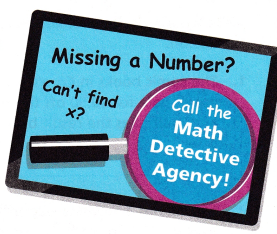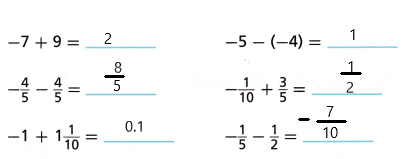We included HMH Into Math Grade 7 Answer Key PDF Module 6 Solve Multi-step Problems Using Rational Numbers to make students experts in learning maths.
HMH Into Math Grade 7 Module 6 Answer Key Solve Multi-step Problems Using Rational Numbers
Can You Find the Mystery Number?
You are the new investigator for the Math Detective Agency. Your first case depends on finding a mystery number. Follow these steps.

A. Find each sum or difference.

Answer:

Explanation:
-7 + 9 = 2
-5 – (-4) = -5 + 4 = -1
–\(\frac{4}{5}\) – \(\frac{4}{5}\) = –\(\frac{8}{5}\)
–\(\frac{1}{10}\) + \(\frac{3}{5}\) = \(\frac{5}{10}\) = \(\frac{1}{2}\)
Next,
-1 + 1\(\frac{1}{10}\)
-1 + \(\frac{11}{10}\)
\(\frac{(-10 + 11)}{10}\)
\(\frac{1}{10}\) = 0.1
Next question,
–\(\frac{1}{5}\) – \(\frac{1}{2}\)
LCM of 5 and 2 is 10
–\(\frac{2}{10}\) – \(\frac{5}{10}\)
–\(\frac{7}{10}\)
B. Plot and label each sum or difference from Part A on the number line.

Answer:

Turn and Talk
The mystery number is the distance between the two closest points that you plotted. What is the mystery number? Explain how you found it.
Answer:
The mystery number is 0.3 as it is the closest point that is plotted in the graph.
From observing the number line the closest points are 0.1 and 0.5. Then the mystery number is 0.3.
Are You Ready?
Complete these problems to review prior concepts and skills you will need for this module.
Write and Interpret Numerical Expressions
Write a numerical expression to express the calculation. Do not simplify the expression.
Question 1.
The comic books in Cora’s favorite series regularly cost $2.99. Today, they are on sale for $0.50 off the regular price. Cora subtracts $0.50 from $2.99 and multiplies the result by 4 to find the cost of 4 comic books at the sale price.
Answer:
The cost of 4 comic books at the sale price is $9.96.
Explanation:
Given,
Cora’s favorite series regularly cost = $2.99
Sale off the regular price = $0.50
The cost of one book = Regular price – sale on regular price
= $2.99 – $0.50
= $2.49
She wants to buy 4 books = cost of 1 book × 4
= $2.49 × 4
= $9.96
So, the cost of 4 comic books at the sale price is $9.96.
Question 2.
Kendal has a 5-pound bag of flour that holds 18\(\frac{1}{2}\) cups. His bread recipe calls for 3\(\frac{1}{4}\) cups of flour per loaf. Kendal starts with 18\(\frac{1}{2}\) and subtracts 5 times 3\(\frac{1}{4}\) to find how much flour he will have left after making 5 loaves of bread.
Answer:
2\(\frac{1}{4}\) cups.
Explanation:
Kendal has a 5-pound bag of flour that holds 18\(\frac{1}{2}\)
18\(\frac{1}{2}\) – 5 × 3\(\frac{1}{4}\)
\(\frac{37}{2}\) – 5 × \(\frac{13}{4}\)
\(\frac{37}{2}\) – \(\frac{(5 × 13)}{4}\)
\(\frac{37}{2}\) – \(\frac{65}{4}\)
LCM of 2 and 4 is 4
\(\frac{74}{4}\) – \(\frac{65}{4}\)
\(\frac{9}{4}\) cups
2\(\frac{1}{4}\) cups.
So he will have left 2\(\frac{1}{4}\) cups after making 5 loaves of bread.
Add and Subtract Rational Numbers
Find each sum or difference.
Question 3.
-5 + 12
Answer:
13
Explanation:
The sum of the given number is 13.
Question 4.
15 – (-7)
Answer:
22
Explanation:
The addition of two minus signs gives (+)
(-) + (-) = (+)
15 – (-7) = 15 + 7 = 22
Question 5.
2.8 + (-8.7)
Answer:
-5.9
Explanation:
(+) + (-) = (-)
2.8 – 8.7 = -5.9
The addition of the two given numbers is -5.9
Question 6.
–\(\frac{3}{5}\) + (-1\(\frac{4}{5}\))
Answer:
–\(\frac{12}{5}\)
Explanation:
let us solve the given expression
–\(\frac{3}{5}\) + (-1\(\frac{4}{5}\))
–\(\frac{3}{5}\) – \(\frac{9}{5}\)
-3 – 9 = -12
–\(\frac{12}{5}\)
Question 7.
–\(\frac{1}{3}\) – \(\frac{5}{6}\)
Answer:
–\(\frac{-7}{3}\)
Explanation:
let us solve the given expression
–\(\frac{1}{3}\) – \(\frac{5}{6}\)
LCM of 3 and 6 is 6
\(\frac{(-2 – 5)}{6}\)
–\(\frac{-7}{3}\)
Multiply and Divide Rational Numbers
Find each product or quotient.
Question 8.
(-3)(-15)
Answer:
45
Explanation:
The product for the given number is 45.
(-) × (-) = (+)
So the answer is + 45.
Question 9.
84 ÷ (-4)
Answer:
-21
Explanation:
The division for the given number is -21.
Question 10.
1.9(-0.04)
Answer:
-0.076
Question 11.
–\(\frac{11}{8}\) ∙ \(\frac{2}{3}\)
Answer:
–\(\frac{11}{12}\)
Explanation:
Given,
–\(\frac{11}{8}\) ∙ \(\frac{2}{3}\)
–\(\frac{11}{8}\) × \(\frac{2}{3}\)
–\(\frac{(11 × 2)}{(3 × 8)}\)
–\(\frac{22}{24}\)
–\(\frac{11}{12}\)
Question 12.
-2\(\frac{1}{2}\) ÷ \(\frac{3}{4}\)
Answer:
–\(\frac{10}{3}\)
Given,
-2\(\frac{1}{2}\) ÷ \(\frac{3}{4}\)
–\(\frac{5}{2}\) × \(\frac{4}{3}\)
cancel the common factors
-5 × \(\frac{2}{3}\)
–\(\frac{(5 × 2)}{3}\)
–\(\frac{10}{3}\)